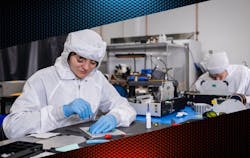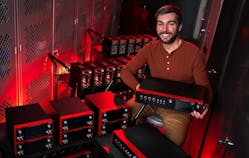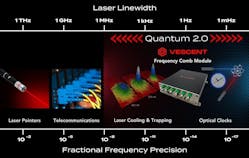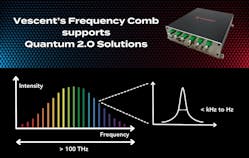Vescent, a provider of Quantum 2.0 technologies which enable commercialization of deployable devices that have, up until now, struggled to escape the lab and live up to their potential, has developed a range of new products to provide the latest in low size, weight, and power (SWaP), ruggedness, and performance for quantum applications. This includes frequency combs (see Fig. 1), lasers, and controls (see Fig. 2) for quantum timing (optical clocks), computing, networking, and sensing.
All Quantum 2.0 technologies leverage a decades-long effort by physicists across the globe to gain tighter control of light and light-matter interactions.
During Quantum 1.0, the invention of the laser gave us dramatically improved control of light—its wavelength (or frequency), directionality, and phase coherence—in ways that revolutionized the world from medicine to communications to manufacturing.
Now, Quantum 2.0 demands even tighter and more nuanced control of light than ever before. In the case of emerging applications that exploit the quantum behavior of atoms, ions, or molecules, light is the tool of choice to coax the desired behavior from these quantum entities.
The amplitude, phase, and frequency of light are the degrees of freedom used to elicit a specific action. But how much tighter control over these degrees of freedom is really required for Quantum 2.0? In terms of relative accuracy, the frequency of the light has the most stringent requirements: an error of just 1 in 10 trillion (1 × 10-13) is often enough to render the light completely useless to the quantum operation (see Fig. 3).
It is a huge lift, but an essential goal if these devices are going to successfully reach the field. Furthermore, these tools must maintain this performance, operating while enduring shock, vibration, and huge temperature swings. The Vescent mission is to provide this phenomenal behavior in real-world conditions.
To their goal of enabling real-world quantum applications, Vescent is shrinking and ruggedizing frequency-stabilized laser modules. The initial products that are transforming the capabilities of deployed quantum systems are modular frequency combs (see Fig. 4) that have been shown to operate as a component of an optical clock over a demanding -10° to 60°C temperature range and while undergoing >1g RMS vibrations. To our knowledge, this is the harshest environment in which any quantum laser control system has been shown to operate to date.
An optical frequency comb is a laser system that inherently connects the optical and microwave domains. Through this unique property, frequency combs support a variety of applications, including optical atomic clocks for improved timing and navigation, quantum computing, and a host of quantum sensors to detect accelerations, rotations, and electromagnetic fields with precision and accuracy beyond the limits of their classical counterparts.
Vescent has miniaturized and ruggedized a host of continuous-wave lasers and their control electronics for pumping and probing atoms. These sources can work on their own or be integrated with optical frequency comb technology.
For example, quantum systems often require reliable relative frequency stability at the 10-14 level. Systems such as quantum computers need to discipline multiple laser frequencies against a master laser that simply put: “just doesn’t move.” Traditional approaches to this problem, such as vacuum-enclosed ultralow-expansion glass high-finesse cavities, can provide short-term stability, but longer-term drift can limit operation uptime.
To address this problem, Vescent is now shipping tools such as a robust optical frequency comb and an acetylene stabilized laser (the Stabiλaser from DFM). This kit enables users to control the frequency of their light source with a relative stability down to a few parts in 100 trillion (<3 × 10-14), depending on the feedback time. By exploiting the lock-step connection between the optical and microwave portions of the spectrum afforded by optical frequency combs, frequency synthesis can be accomplished from one portion of the spectrum to the other. Thus, the high stability of a source can be transferred to and from any wavelength from 500 to 2000 nm in the optical domain and to and from harmonics of the 100- or 200-MHz repetition rate of the comb up to 10 GHz.
In a recent example, a Vescent customer approached the team with a problem: their quantum application required a laser that needs to maintain both its fractional linewidth and its relative frequency stability to better than 5 × 10-14 for their quantum operations to work.
Using a state-of-the-art, ultralow-expansion (ULE) cavity-stabilized laser, they achieved the required linewidth, but the characteristic instability of the cavity means that, due to uncontrolled drift, recalibration of the laser frequency was needed every few minutes before operations could continue.
This repeated downtime is an unacceptable barrier to widespread real-world utility of Quantum 2.0 devices. To address this, Vescent developed a frequency stability kit so users can now discipline their ULE cavity-stabilized laser frequency to a relative instability of better than 5 × 10-14 for days at a time. This combination of the narrow linewidth of the reference laser and the low drift controlled by the Vescent kit led to an estimated 30–300X improvement in operational uptime for the user’s system, dramatically improving both the utility and capabilities of their quantum application.
Vescent is in the vanguard of the Quantum 2.0 revolution in sensing by deploying quantum-based devices and methods in the field. They offer lasers, combs, and controls that have been ruggedized and have already proved their utility in the field.



